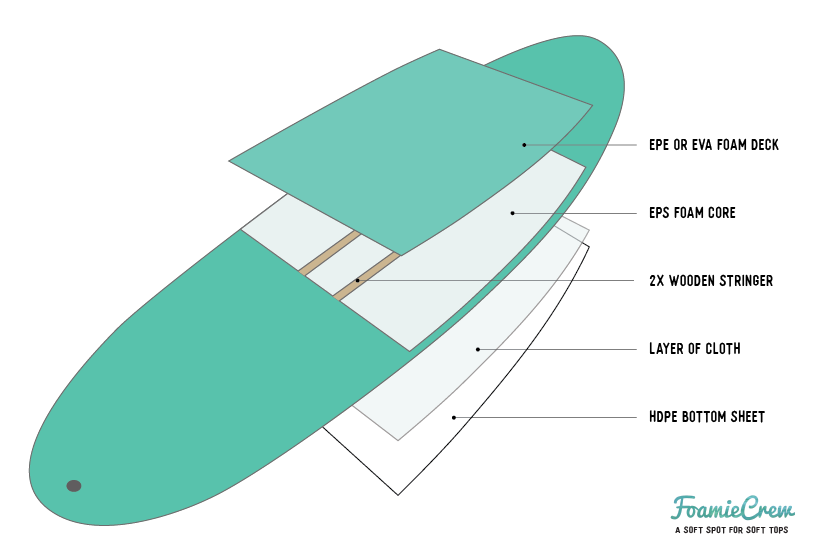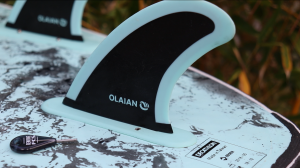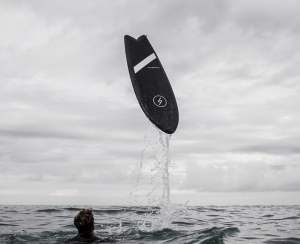Generally, soft top surfboards are mass produced toys. Sure, we are seeing the rise of surf board brands producing hand-build soft tops and local shapers experimenting with custom foam crafts. But 99% of the foam boards in the lineup have their origin in a large factory. Most foamies are a result of automated processes. We’ll describe the most common method here.
The development of a soft top board starts with a prototype. The shaper designs a board that meets the requirements of the intended user. After drawing the board in a CAD program the blank can be cut by a CNC milling machine see the video below. Up to this point, this is no different than how a usual rigid surf board is developed.
The CNC machine turns a square piece of EPS into the desired shape. After the blank leaves the cutting machine it needs some manual sanding to smoothen some ridges.
Fiberglass or not?
Some foam boards, usually the more high-end ones, have a layer of fiberglass. The blank will be wrapped with one or more layers of 6 oz fiberglass cloth. For heavy duty boards, such as SUP’s, an extra layer of Polycarbonate will be added to prevent the bottom from dents. We’ll explain more on that later.
The biggest difference in terms of manufacturing is the top layer. A foamie has a soft, dentable EVA + PC top layer where a rigid surfboard has a hard fiberglass top layer.
The thing that all foamies have is an upper layer that consists of a textured EVA sheet. This sheet is glued to the fiberglass or synthetic wrap of the foam core. Then, the plastic layers have to firmly put together. Usually the board will be cured by a vacuum bag to equally distribute the pressure over the surface of the board.

This infographic shows how the largest part of the mass-produced soft top surfboards are composed. Except for the stringers – all materials are types of synthetics.
If you’re willing to spend a bit more on a foamie, chances are that the boards anatomy looks different than pictured above. The more high performance soft tops have an extra layer of fiberglass around their core. This makes the board more stiff which you’ll notice when you’re surfing. A stiffer surfboard makes it easier to do turns in the wave. A soft top board that lacks stiffness – and thus has high flexibility – can feel a bit draggy.
This isn’t a problem when you’re riding down the line or learning how to surf.
However, if you’re looking to throw big snaps with your foamie – it’s probably smart to look for a soft top construction that includes a fiberglass layer of some sort. This will make the board less flexible which you will feel in your riding experience.
Stringers
Most foam surfboards are made out of an EPS blank with wooden stringers. All the Olaian boards, such as the 900 6′ and the smaller Olaian 5’4 twin fin, have wooden stringers, as do the Indio ones. However, some brands such as SkunkWorks use aluminum tubes – as aluminum is very lightweight and doesn’t absorb water. Generally, up to 7 ft it’s common to find 2 stringers. Above 7 ft it’s common to have 3 stringers. Some brands such as Catch Surf integrate 3 stringers even in small boards to enhance stiffness.
Fins
Entry-level foamies or foamies that are specifically produced for surf schools have soft fins or soft edge fins. These are rigid plastic fins with bendable rubber edges to avoid injuries and dings. These entry-level boards will often have simple fin boxes that you can screw in on the top of the board – using a fin or a coin.

The more performance oriented foamies will have finboxes that allow you to plug in the fins of your choice. During the shaping process holes are cutted where the finboxes go later on. As one of the final steps the fin boxes are pushed into the holes in the soft top board.
How environmentally friendly is a soft top surfboard?
Honestly, I’ve been looking for a soft top long before I bought one. I was convinced of the foamie fun factor and the durability was definitely an advantage, too.
But at the same time, I questioned the sustainability of the materials used in a soft top and it’s overall ecological impact. It’s commonly known that these boards are all products of the petrochemical industry. But so are standard surfboards. What makes a soft top different, then? Let’s dive deeper into the ecological footprint of a foamie.
What makes soft tops harder to recycle than rigid glassed boards is that all layers are glued together. As the glue blends with the molecules of the other synthetics – it makes it virtually impossible to ever separate the materials again.
One of the most toxic materials in the surf industry is resin. A soft top board requires less resin than a rigid board. However, EVA and Polycarbonate layers are needed and both of these plastics have a negative environmental impact.
The core or blank of a surfboard remains hard to recycle. It’s also not easy for companies to source more sustainable EPS foam cores, but some big steps have been made recently. You really have to check out Marko Foam and their Formula Fun, if you want to read more about sustainable foam.
Where we also find innovation is in the outer layers of the soft tops. We’ve seen a growing amount of young companies using recycled plastic for the outer EVA or EPE decks. An example is Spooked Kooks from Australia. Spooked Kooks’ mission is to make the best performing and most durable softboards containing as much recycled plastic waste as possible. “100% of all high-density polyethylene used in our boards is recycled post-consumer plastic waste. This includes the entire “slick” (underside of the boards), leash plug, fin boxes, fins and fin key.”

Soft top surfboards – Made in Asia
Are soft top boards all ‘Made in Asia‘? Countries like China, Indonesia and Taiwan are host to the worlds largest surfboard factories. Well known surfboard brands such as Firewire, Webber and Torq have their boards produced in these countries where manufacturing know-how is high and costs of labor are low. For soft top boards, this is no different. Some brands have their own factories, others have manufacturing partners overseas and co-develop their models. For example, Olaians’ prototypes are made in Hendaye, but their boards are mass produced in Taiwan.
Although some soft tops are manufactured close to their market, the main ingredients for the pie still have to be shipped from the other side of the world.
Most brands aren’t particularly open about where their boards are produced. If they are produced domestically, they will be sure to let their customers know. That likely means that if they’re silent about about the manufacturing location of their goods, well, chances are high that indeed, their boards come from the far east.
Hand shaped soft top surfboards
Recently, we have seen a counter movement of hand shaped soft top boards. We’re hoping to publish more about this soon!
![]()





How would i make one of these at home? How would i go from blank to surfboard? And what supplies would i need?
Hi Kurt! For this article we interviewed a product developer that has all the knowledge about large-scale production. How to DIY a soft top? We thought about starting that project many times, haven’t got to it! (the waves have been good this winter). We did find this video by Eric Russel https://www.youtube.com/watch?v=yGFzgYfbjBg
How to build a surfboard using Home Depot insulation foam boards. This video provides step by step instructions with pictures of how to make a surfboard including material lists and frequently asked questions.
Interesting article. I wanted to ask which kind of glue is used to glue the EVA on fiberglass and which for EPS
Hi Felix! It depends on the manufacturer, but we’ve seen some manufacturers use 3M glue. You might want to contact them for the specifics on adhesives for water sports.
Hi, guys! I’m curious about this top EVA foam layer. What it the typical thickness and what kind of EVA it is? Is it the same that Cosplayers use to make their costumes? Or is it a highly specific one?Thanks for the article, is super interesting!
Hi Guys, thanks for the article! It’s super useful! Do you know a bit more about this EVA foam layer? Some sources say it’s a high density EVA, but how high is “high”? :/ How thick is normally the layer? Is it the EVA that cosplayers use to make their costumes?
Thanks!